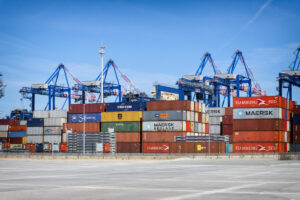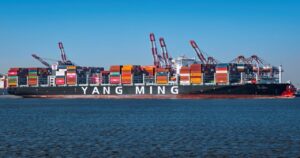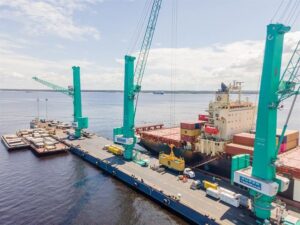In an exclusive PTI blog, Klaus Lysdal, Vice President of Sales and Operations at digital freight forwarder iContainers, lists five challenges the logistics industry is facing on its journey towards digital transformation. These are among the many issues that will be discussed and debated at PTI's Container Terminal Automation Conference (CTAC) in London on 6-8 May 2019.
The digital revolution is not only transforming the way businesses are being managed, but it’s also dictating the way the world communicates.
How is shipping, such an age-old industry and one that’s so set in its ways, approaching this digital approach? To understand the digital revolution in shipping, one must first understand the demands needed to keep pace.
Hybrid workforce
As technology moves to the forefront of logistics, businesses will need to rethink their hiring strategies as the nature of jobs transforms.
Already, the shipping industry is beginning to see more of a hybrid workforce. For years now, the goal of many companies, especially the larger freight forwarders, has been to build systems to internally replace operational staff. The end game is for these systems to take charge and do what operational work they can and have staff perform the tasks that the systems can’t do.
Skills that are considered valuable will be redefined and new or fusion skill sets will be required for successful operations. Employees will likely move towards new roles in management and programming as basic logistics tasks get automated. There will also be new approaches to solution solving and problems. All this — while managing the human-machine co-existence.
Customer centricity
With technology running the show, customers will naturally increase their demand for speed and accuracy. To fulfill these demands, it is imperative that businesses take on a customer-centric approach.
That doesn’t mean simply tweaking departmental and operational focus and adjusting objectives to include KPIs and metrics that measure customer satisfaction. It requires a revamp and an overhaul of the entire business structure.
A recent PTI Insight looked at the 'The Future of Digital Logistics'
While service reliability is still a make-or-break factor for today’s customers, their main concern is no longer whether a service is pulled off. Efficiency and convenience have now become important factors of what’s deemed to be a reliable service. To that end, company focus must be on customers from the top down as much as it is from the bottom up so that it’s etched into every single employee’s mind and reflected in their work.
It’s a cyclical process and the logic is simple. The digital revolution promises efficiency, which lures customers, who propel demand.
Transparency
Customers are stepping up their demands for real-time logistical updates. But unfortunately, the industry is still far from being able to offer the full transparency they call for.
The two issues surrounding transparency that are currently being tackled are rates and operational transparency. But both have their shortcomings. With rates, there’s a problem of being incredibly difficult to keep up with them and fully calculate exactly how charges are going to work out.
A brand new Port Technology technical paper looked at the future of smart investment, including AI and IoT
Operational transparency sounds simple and something that should be easy to achieve. But herein lies the real challenge. The overall process generally contains so many separate wheels spinning and so many stopping blocks that it becomes a highly complex task to create something that efficiently offers visibility over every aspect. Even the best-laid plans can tumble like a house of cards when you pull out one of the bottom cards, such as when a vessel delay changes the sailing schedule or a depot runs out of equipment.
If the industry can find a way around these, clients will be able to see exactly what's going on with their shipment and the costs involved. It will then be much easier to be able to introduce the next level: service transparency.
This upper level will provide customers with a window through which they can catch a glimpse of everything that’s going on behind the scenes. From customs clearance to scheduled pickups and deliveries, It won’t simply be answering the rigid question of what’s going on with my shipment but what’s being done about my shipment.
Technology
Thanks to the emergence of new technologies, digitalization in shipping has been able to experiment and advance.
Technologies such as the Internet of Things (IoT), Big Data, and Artificial Intelligence and their predictive capabilities have all in one way or another allowed for smarter and more efficient supply chains. Already, we’re seeing a boom in smart warehousing, real-time tracking and visibility of transportation.
Blockchain will also introduce a new layer of transparency and credence between supply chain players. Just recently, the technology was successfully implemented on instant e-Bill of Lading transfer. It’ll be interesting to see how this develops further down the road.
The shipping industry will need to adapt quickly — especially shipping lines. As it stands, certain carriers are still struggling to maintain even their own schedules correctly on their websites. And as long as the industry continues to face those types of issues, it will slow down the pace of digitalization.
Data security
With the rise of digitalization and technology, data integrity and privacy challenges and risks have soared. From private businesses to government institutions and non-profits, every single entity is under pressure to ensure the proper safeguard of personal data — but this won’t be easy.
The shipping industry is still far from being able to assure itself that it’s able to safeguard the data being communicated across players. The cyber attacks on Maersk and Cosco over the past couple of years are clearly evident enough that more can be done to beef up cybersecurity or risk crippling operations that can have profound logistical effects.
On one hand, there’s a growing call for more connectivity. But as more systems get connected and more remote controlling capabilities emerge, the risk of data being compromised increases.
Failure to protect this data will surely put the brakes on the digital revolution as this represents a risk not only for the end customers but for the suppliers as well.
Read more:
Klaus Lysdal is currently the Vice President of Sales and Operations at iContainers (USA) Inc. Prior to this role, Mr. Lysdal was at Shipco Transport Inc for more than 12 years during which he was the Manager of Regional “Full-Container Loads” Exports in the South Eastern US region from March 2006 to April 2015. In addition, in the last few years at Shipco Transport, Mr Lysdal managed their nationwide project cargo division and their US East Coast Documentation Center.









